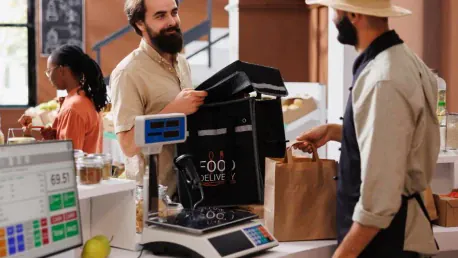The retail and hospitality industries are undergoing a significant transformation, driven by the latest advancements in Point of Sale (POS) technology. Since the 1970s, POS systems have evolved from simple cash registers to sophisticated business management hubs. Today’s POS systems are no longer confined to handling basic cash transactions; they now encompass a wide array of functionalities that streamline operations and enhance customer experiences. This article explores the key trends in POS technology that are set to revolutionize business operations in 2024, reshaping the way retailers and hospitality businesses manage their activities.
The Shift to Cloud-Based POS Systems
One of the most significant trends in POS technology is the move to cloud-based systems. Traditional POS terminals, which are hard-wired and challenging to manage, are being replaced by cloud POS systems. A clear indicator of this shift is the global cloud POS market, which was valued at $3,987 million in 2022 and is projected to grow to over $30,205 million by 2031, portraying a compound annual growth rate (CAGR) of 24.7%. This substantial growth is a testament to the rising adoption of cloud POS technology across various sectors.
Cloud POS technology offers numerous benefits, including data accessibility, operational agility, and seamless synchronization across multiple locations. This mobility allows retailers to manage their business from any location at any time, making it an attractive option for both large and small businesses. By enabling real-time data updates and remote management, cloud-based POS systems ensure that businesses can operate more efficiently, reducing downtime and improving overall productivity.
Furthermore, cloud POS systems can easily integrate with other business applications, providing a comprehensive solution for managing various aspects of a business. Whether it’s inventory management, sales tracking, or customer relationship management, cloud POS systems offer a unified platform that simplifies operations. This integration capability is particularly beneficial for businesses with multiple locations, as it allows for centralized control and monitoring of all operations from a single dashboard.
AI and Automation Enhancing Business Operations
Artificial Intelligence (AI) and automation are making significant inroads into POS systems, enhancing various aspects of business operations. A survey by Square Future of Retail revealed that all retail business owners reported some form of improvement in their operations due to automation. The most notable benefit, experienced by 47% of businesses, is an improved customer experience. This highlights the importance of AI and automation in creating a seamless and satisfying customer journey.
AI and automation in POS systems facilitate functions such as automated inventory reordering, fraud detection, AI-powered pricing, and enhanced loyalty programs. Automated inventory reordering ensures that businesses maintain optimal stock levels, reducing instances of stockouts or overstocking. Fraud detection algorithms help identify and prevent fraudulent transactions, enhancing security for both businesses and customers. AI-powered pricing strategies enable businesses to adjust prices dynamically based on factors such as demand, competition, and market trends, maximizing profitability.
Beyond these functionalities, AI assists in creating dynamic product descriptions, pricing, and providing tailored product recommendations. By analyzing customer data and purchase history, AI can suggest products that are more likely to appeal to individual customers, increasing the likelihood of sales. This personalized approach not only boosts sales but also fosters customer loyalty, as customers appreciate the tailored shopping experience. Overall, the integration of AI and automation in POS systems streamlines business operations, reduces human error, and enhances the overall efficiency of retail and hospitality businesses.
Diversification of Payment Options
The diversification of payment options available at the point-of-sale terminal is another significant trend. Payment methods now span from cash and traditional card payments to modern options like mobile wallet apps, QR code payments, touchless card payments, and buy-now, pay-later services like Clearpay. The availability of multiple payment options caters to evolving consumer preferences and provides a more flexible and convenient shopping experience.
According to Square, payment preferences among retailers are diverse: 58% accept cash, 57% accept mobile wallets, and 52% use QR code payments. This variety reflects the growing demand for contactless and digital payment methods, driven by technological advancements and changes in consumer behavior. POS systems are adapting to integrate these various payment options, ensuring they meet the needs of modern consumers.
The integration of diverse payment methods not only enhances the customer experience but also increases the potential for sales. By offering multiple payment options, businesses can cater to a broader audience, including those who prefer digital wallets or installment payment plans. This flexibility can be particularly beneficial during peak shopping periods or sales events, where convenience and speed are crucial for customer satisfaction. Overall, the diversification of payment options is a key trend that is shaping the future of POS technology and retail operations.
The Rise of Mobile POS (mPOS) Systems
Mobile POS (mPOS) systems are emerging as another key trend, forecasted by Statista to reach a market value of around $3.78 trillion by 2028 with more than 2 billion users. The mPOS enables sales associates to process purchases from anywhere on the sales floor, eliminating the need for queues. This mobility not only enhances the shopping experience but also supports retail staff in performing tasks like barcode scanning and inventory counts more efficiently.
The convenience and flexibility offered by mPOS systems are driving their adoption across various retail sectors. By allowing sales associates to assist customers and complete transactions anywhere in the store, mPOS systems reduce wait times and improve overall customer satisfaction. This is particularly valuable during busy periods when long queues can lead to frustrated customers and lost sales. The ability to provide a more personalized and efficient shopping experience gives retailers a competitive edge in a crowded market.
In addition to improving the in-store experience, mPOS systems also support other aspects of retail operations. For instance, they enable more accurate inventory management by allowing staff to update inventory data in real-time. This reduces the likelihood of stock discrepancies and ensures that customers have access to up-to-date information on product availability. Overall, the rise of mPOS systems represents a significant shift in the retail landscape, offering increased convenience, efficiency, and customer satisfaction.
Expansion of Self-Checkout Options
Self-checkout options are expanding beyond grocery stores to other retail sectors, reflecting consumers’ desire for speed, efficiency, and autonomy in their shopping experience. As more consumers prefer independently handling tasks such as checking product inventory, ordering out-of-stock items, and using mobile checkout, retailers are responding by implementing self-checkout systems that cater to these preferences.
The drive toward self-serve options underscores consumers’ increasing comfort with technology and their expectation for fast, efficient service. Self-checkout systems allow customers to scan and pay for items without the need for cashier assistance, reducing wait times and streamlining the checkout process. This not only enhances the shopping experience but also frees up staff to focus on other tasks, such as assisting customers on the sales floor or managing inventory.
Furthermore, self-checkout systems are increasingly incorporating advanced technologies to improve their functionality and security. For instance, some systems use AI to detect potential theft or fraud by analyzing patterns of behavior and flagging suspicious activities. Others integrate with mobile apps to allow customers to scan items with their smartphones and complete their purchase without having to use a physical checkout terminal. As self-checkout options continue to evolve, they are set to become an integral part of the retail landscape, offering a fast, efficient, and convenient shopping experience.
Biometric Security in POS Systems
Biometric security is another progressive trend in POS technology, with an anticipated CAGR of 113.6% from 2024 through 2028. Security measures such as fingerprint identification and facial recognition are gaining traction, offering enhanced protection for both business operations and customer data. The adoption of biometric payment authentication is driven by the need for more secure and efficient methods to verify identities and authorize transactions.
Beyond security, biometric systems enhance efficiency by simplifying the login process for employees and authenticating customer payments swiftly. By using unique biological characteristics, such as fingerprints or facial features, biometric systems reduce the risk of unauthorized access and eliminate the need for passwords or PINs, which can be lost or stolen. This leads to a more secure and streamlined experience for both employees and customers.
The implementation of biometric security in POS systems also supports compliance with data protection regulations as biometric data can be securely stored and managed. This helps businesses mitigate the risk of data breaches and build trust with customers, who are increasingly concerned about the privacy and security of their personal information. As biometric technology continues to advance, it is likely to become a standard feature in POS systems, offering a higher level of protection and convenience for businesses and consumers alike.
Recommended POS Systems for Small Businesses
The retail and hospitality industries are experiencing significant shifts, driven by cutting-edge advancements in Point of Sale (POS) technology. Since their inception in the 1970s, POS systems have transformed from basic cash registers into comprehensive business management hubs. These modern POS systems go far beyond mere cash transactions, offering a myriad of functionalities that streamline operations and greatly enhance customer experiences. In 2024, emerging POS technology trends are poised to revolutionize business practices, reshaping how retailers and hospitality enterprises manage their activities. Mobile POS systems, integrated CRM capabilities, and advanced analytics are some of the innovations enhancing efficiency and customer satisfaction. With the ability to process multiple payment types, track inventory in real-time, and provide valuable sales insights, modern POS systems are integral to business success. As technology rapidly evolves, businesses must adapt to stay competitive, leveraging these advanced POS systems to optimize operations and deliver superior service.









